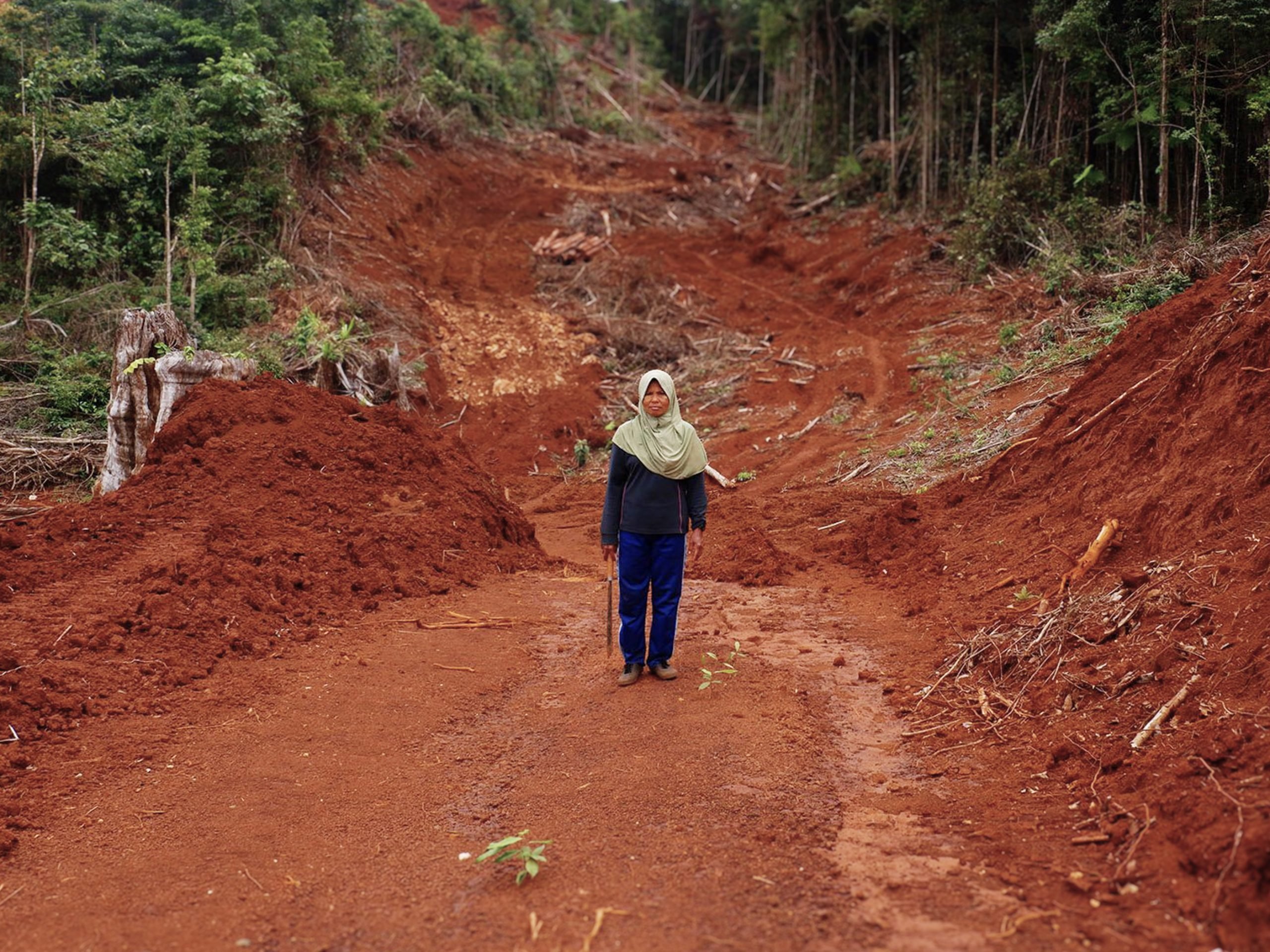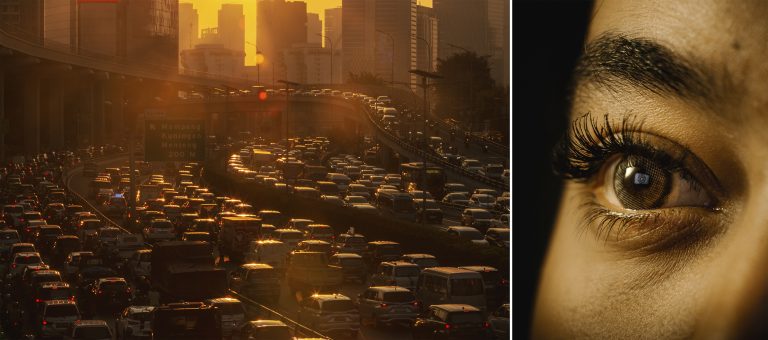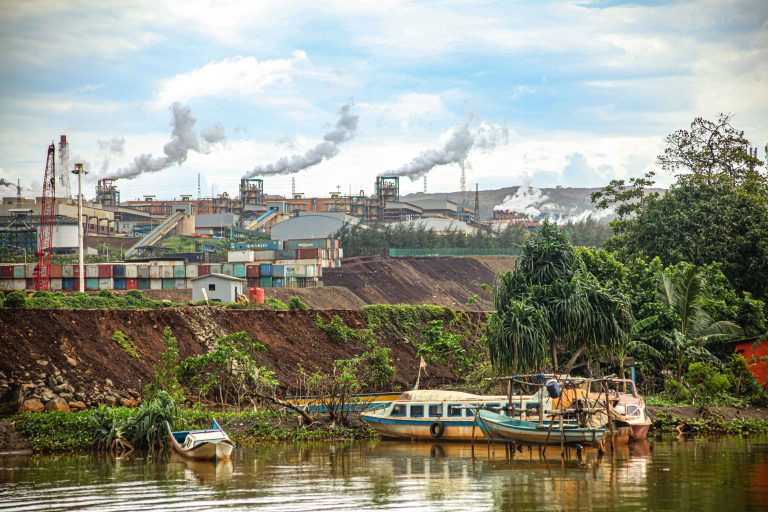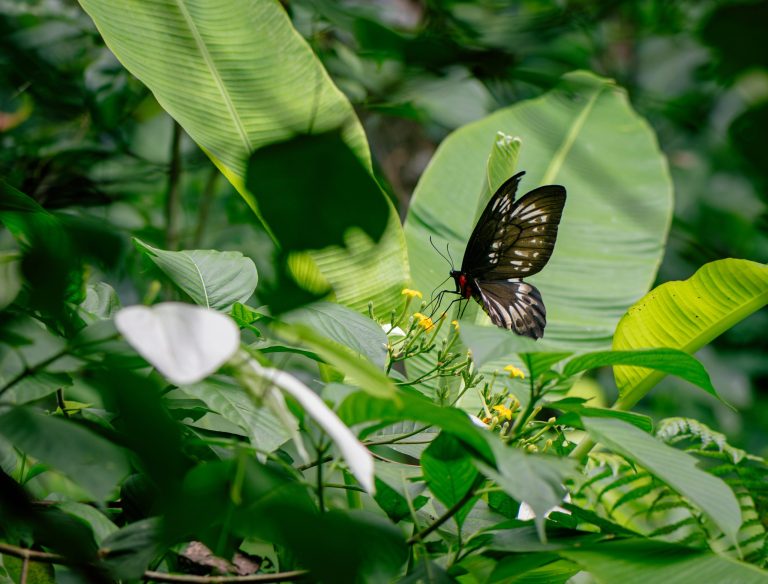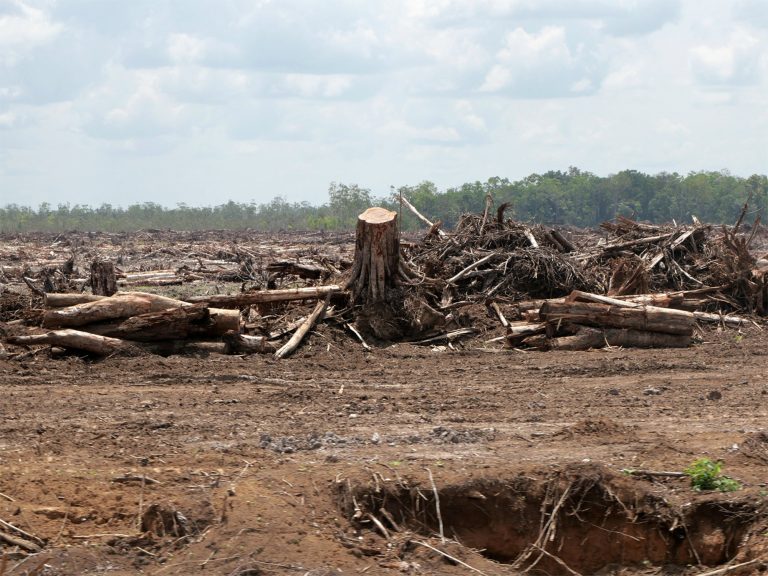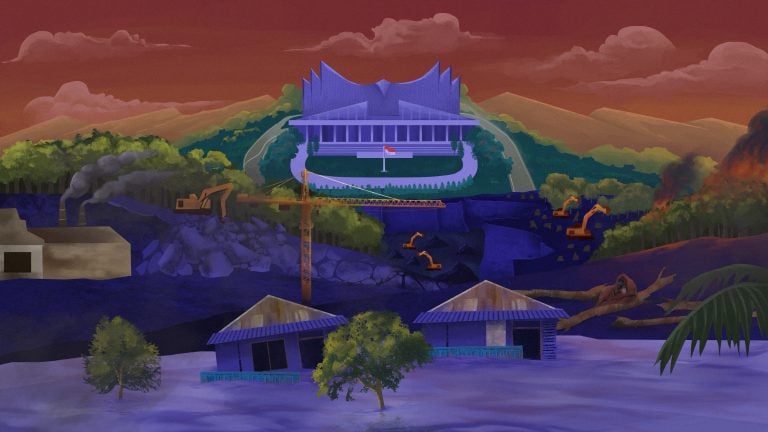Nickel companies are destroying the environment on Indonesia’s small islands and threatening local livelihoods. As ecosystems are compromised, communities struggle to survive.
Indonesia is home to the world’s largest nickel reserves, and with this resource, the government aims to position the country as a leading battery producer for the global electric vehicle (EV) industry.
Yet this ambition has fueled a surge in nickel mining and smelting activities that often bypass regulations, threatening fragile ecosystems unique to small islands.
Under Law No. 1 of 2014 on Coastal Zone and Small Islands Management, mining operations on islands smaller than 2,000 square kilometers are prohibited. A mining company tried to overturn the protection by submitting a case to the Constitutional Court, which in March 2024 rejected the request. But even after the Court’s ruling, several companies continue their operations, causing extensive environmental damage, particularly on small islands like Kabaena (873 sq km), Wawonii (715 sq km), and Gebe (224 sq km).
The devastation isn’t limited to these very small islands; even a relatively small one like Obi (2,542 sq km) has suffered severe environmental harm. Although not protected by the same law, islands under 10,000 sq km, like Obi, are generally considered small and more vulnerable to environmental impacts.
Beyond ecological damage, these nickel mining and smelting operations have also disrupted the livelihoods of people who depend on natural resources. The companies, some linked to Chinese investment, however, deny responsibility for environmental damage, often attributing issues like water pollution to natural causes such as heavy rainfall.
Project Multatuli has investigated the struggles and resistance of these communities. The following are synopses of their stories.
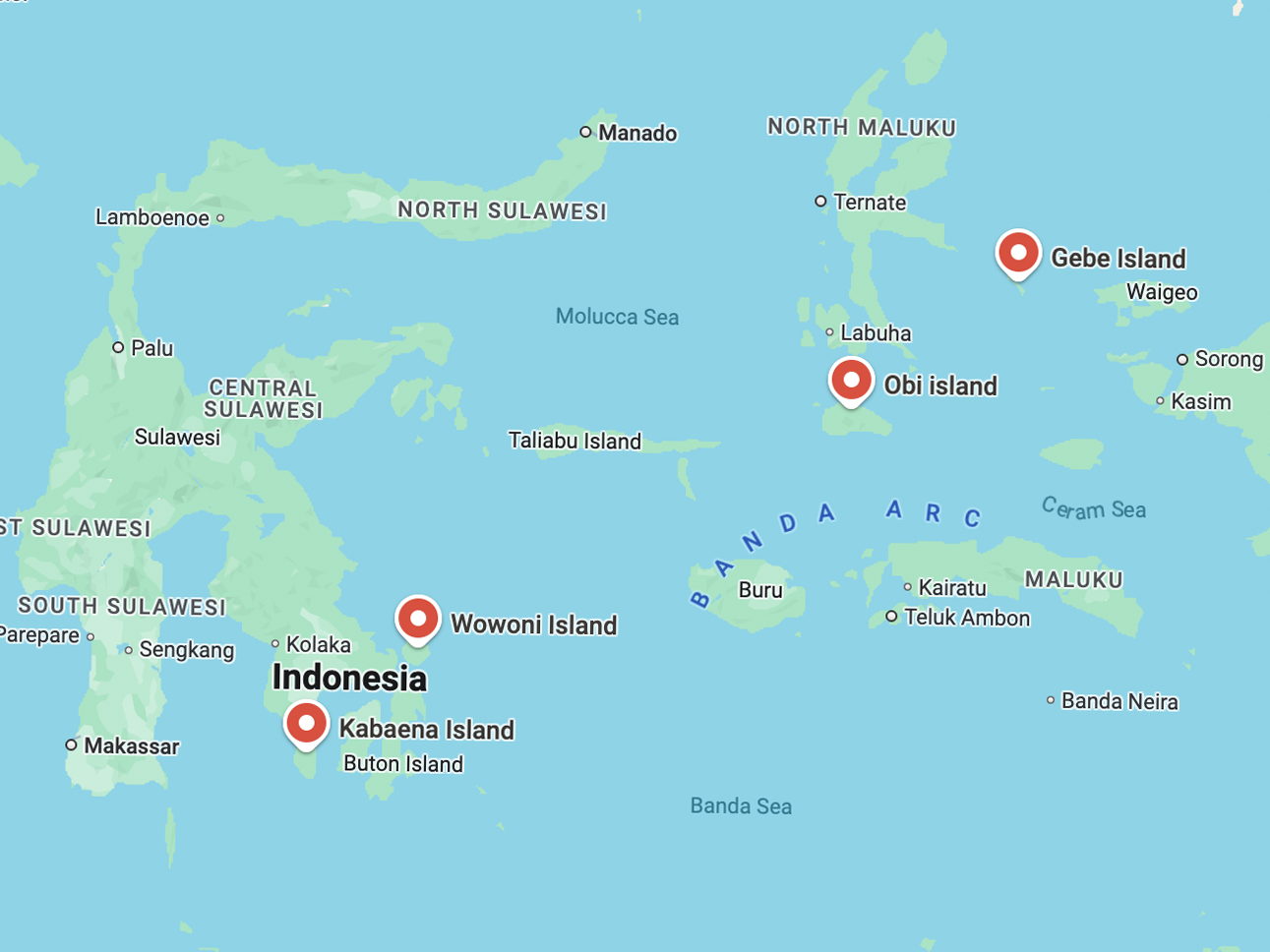
Once Nickel Arrived, the Entire Island Became Polluted
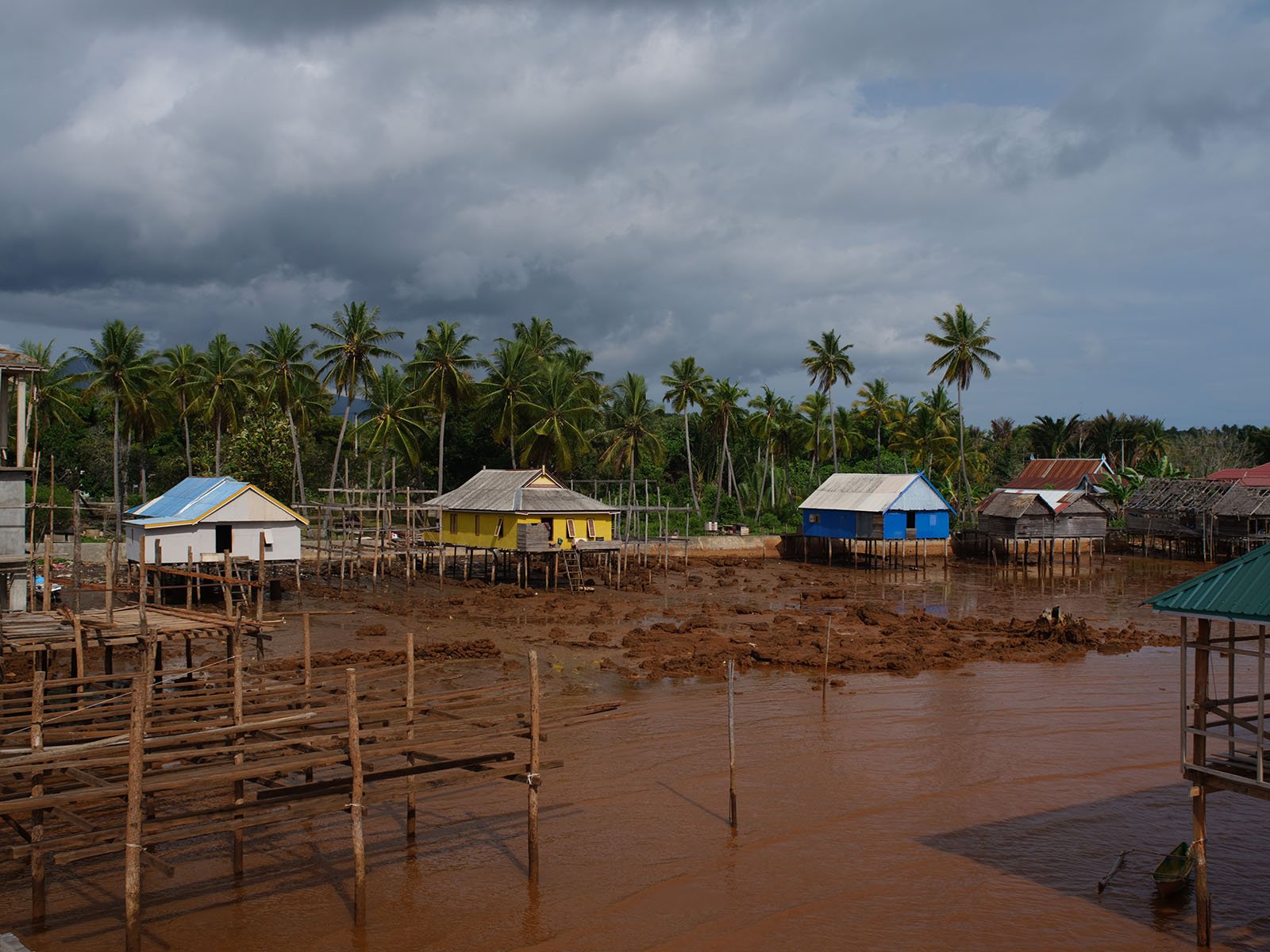
Like most villagers in Baliara on Kabaena Island, who are predominantly from the Bajau or Bajo tribe, Coga is a seaweed farmer.
The middle-aged man used to farm seaweed in the clear coastal waters, just a short walk from his home. But after nickel mining operations began, the water turned murky and reddish-brown, and seaweed no longer grew there, forcing Coga to move his farm 20 minutes away by motorized canoe.
Kabaena, spanning just 873 square kilometers, now hosts 15 active mining licenses, with companies such as PT Timah Investasi Mineral (subsidiary of state-owned company PT Timah) and PT Trias Jaya Agung operating across 73% of the island.
The impact of nickel pollution extends to fishing, as fish have become scarce in coastal areas accessible by small boats. Bajo fishers now venture into deeper waters to fish, even though their boats are unsuitable for long journeys.
Jamaluddin, 50, a resident of Batuawu Atas Village, requested help from a nickel mining company to purchase a 30-ton fishing boat, which would allow the fishermen to venture further out to sea. But the company turned down his request.
“The company told me I had addressed the request to the wrong department. It should’ve been directed to the government,” Jamaluddin said.
Muhali, 55, another resident of Batuawu Atas village (around 16 kilometers from Baliara), tries to adapt by building fish cages so he doesn’t have to go too far into the ocean. But, Muhali said, creating a fish cage costs around Rp15 million (US$1,000)—a significant expense given that the area’s minimum monthly wage is around US$213.
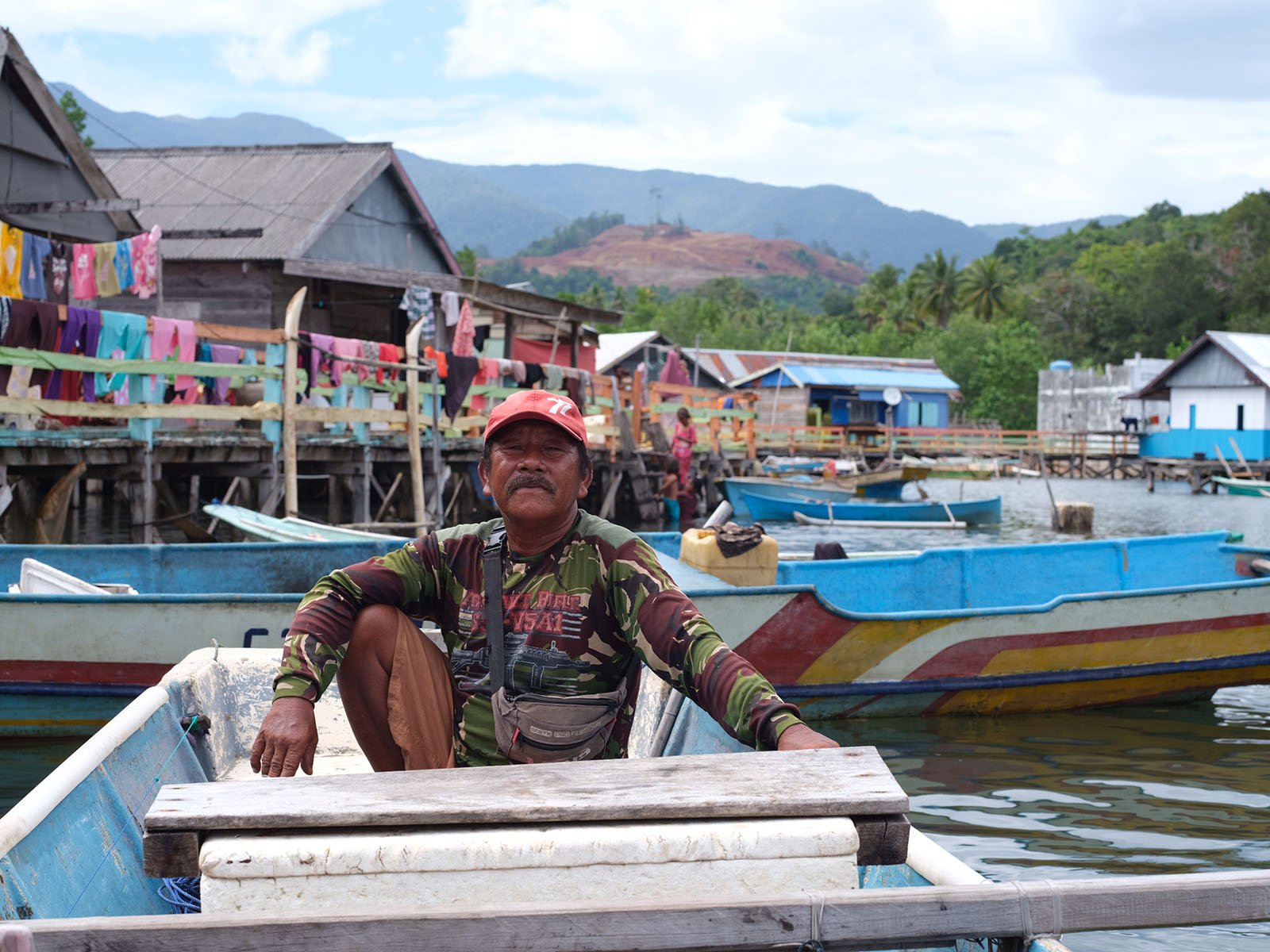
Even with fish cages, challenges persist. Pufferfish tear through the nets, strong winds and tides cause damage, and finding small fish for feed has become increasingly difficult, as nickel dust has destroyed the surrounding mangroves, Muhali said. These mangroves once supported a variety of marine species that coastal communities depend on for their livelihood.
Left with no other option, Muhali resorts to using dynamite fishing to catch small fish, further complicating fishing efforts and harming the marine ecosystem.
The mining pollution impacts more than just Kabaena’s coastal waters. Thick nickel ore dust pollutes the air, forcing Muhali to clean his nets every other day to remove the buildup, adding to his already exhausting workload.
The dust causes respiratory issues among residents, too. According to data from the Public Health Center in Batuawu village, between 2021 and 2023, respiratory disorders or acute respiratory infections ranked first and second among the top 10 diseases reported by residents.
The Struggle of Women on Wawonii Island
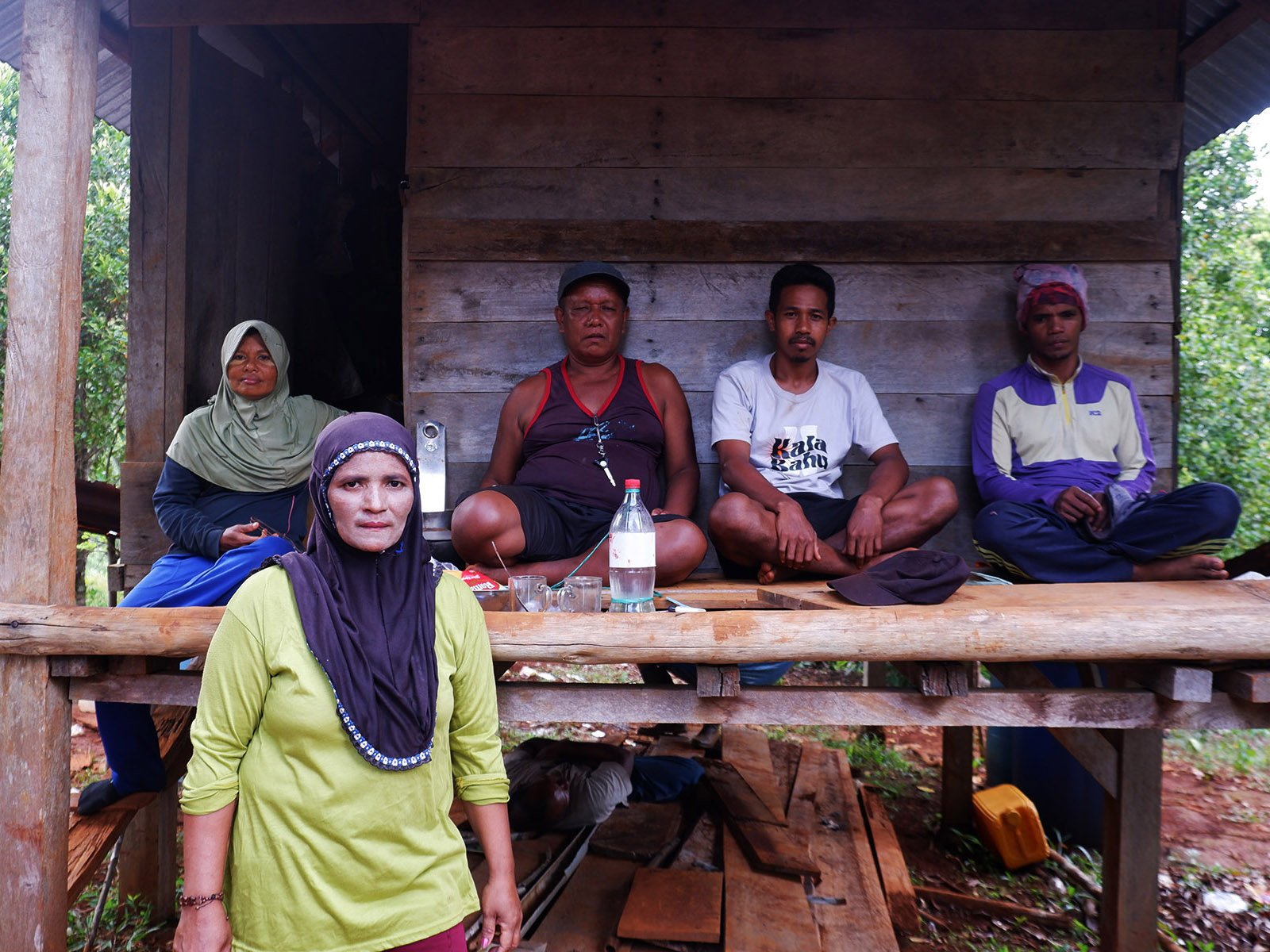
Hastati’s Story
Hastati, 45, a resident of Sukarela Jaya village, is a farmer. She grows coconuts, nutmeg, cloves, and cashews on the family’s 2-hectare plantation.
In recent years, however, life on her plantation has grown challenging.
Clean water, once readily available from wells, has become scarce. For daily water use—including cooking—Hastati now must collect it from a river.
Project Multatuli found that the Banda Spring, which supplies five villages including Hastati’s, has turned murky due to mining by PT Gema Kreasi Perdana, a subsidiary of the Harita Group.
Read also: China in the Downstream: Beijing Tightens its Stranglehold on Indonesia’s Nickel Industry
The nickel company offers clean water, but Hastati and some other residents refuse to accept it as a protest against the mining activities.
At one point, a mining company offered Hastati Rp 1 billion, along with promises of a free pilgrimage, educational aid for her children, and a job at the mine. But, like many others on Wawonii Island, she turned it down.
“We want to protect our land and Wawonii Island. It’s better for us to stand on our own,” Hastati said.
In 2022, Hastati joined other women in a bold protest, stripping off their clothes to resist the mining operation.
Later, fearing arrest, she and eight other villagers hid in the forest for nearly two months. They scattered during the day and took shelter in huts at night. Sometimes, they went to bed hungry; other times, they survived on spoiled boiled cassava.
Amlia’s Story
Amlia was one of those hiding in the forest with Hastati. She had refused to sell her land to the mining company. One day, she said, the police called her to be a witness, but she didn’t understand the case. The police had only called landowners. Worried about being imprisoned, they decided to flee.
Like Hastati, Amlia is a farmer. She and her husband used to reach their field by a 20-minute motorbike ride. But now, they have to walk for two kilometers from where they park their bike, over hilly terrain, as a mining company has occupied their usual route.
On harvest days, their journey is much harder, as they have to carry 20 to 30 kilograms of cashews or cassava on their backs.
Saharia’s Story
In Dompo-Dompo Jaya Village, the murky tap water forces Saharia, 50, a single mother of four, to set basins on her rooftop to catch rainwater.
She often hauls a sand cart to collect water from the Roko-Roko River—500 meters from her home—or from a neighbor’s well. This chore adds to her already exhausting duties as the breadwinner and caretaker of her household.
As the family has limited clean water options, they have cut back on water use, even restricting showers—a particular challenge for the four women in the household, especially during their periods.
They still sometimes use tap water to shower, which often leaves their skin feeling itchy, making Saharia worry about their health.
Ristan’s Story
In Mosolo Village, Ristan, 24, struggles to soothe her baby, Abyan, who suffers from severe itching.
When he was just five months old, tiny spots appeared around his calves, then spread to his toes and soles. The 9-month-old baby’s legs are now covered in black wounds, scarred from months of scratching.
Ristan’s husband and parents have developed black spots and itching, too. Her mother, Nahati, 65, has lived there since she was a child and never experienced this kind of skin disease until the mining activities began nearby.
The family’s water source for daily use, including showers, is just 500 meters from a mining site. Every time it rains, the water becomes muddy, though they have no choice but to use the murky water.
The Company Denied Pollution Accusations
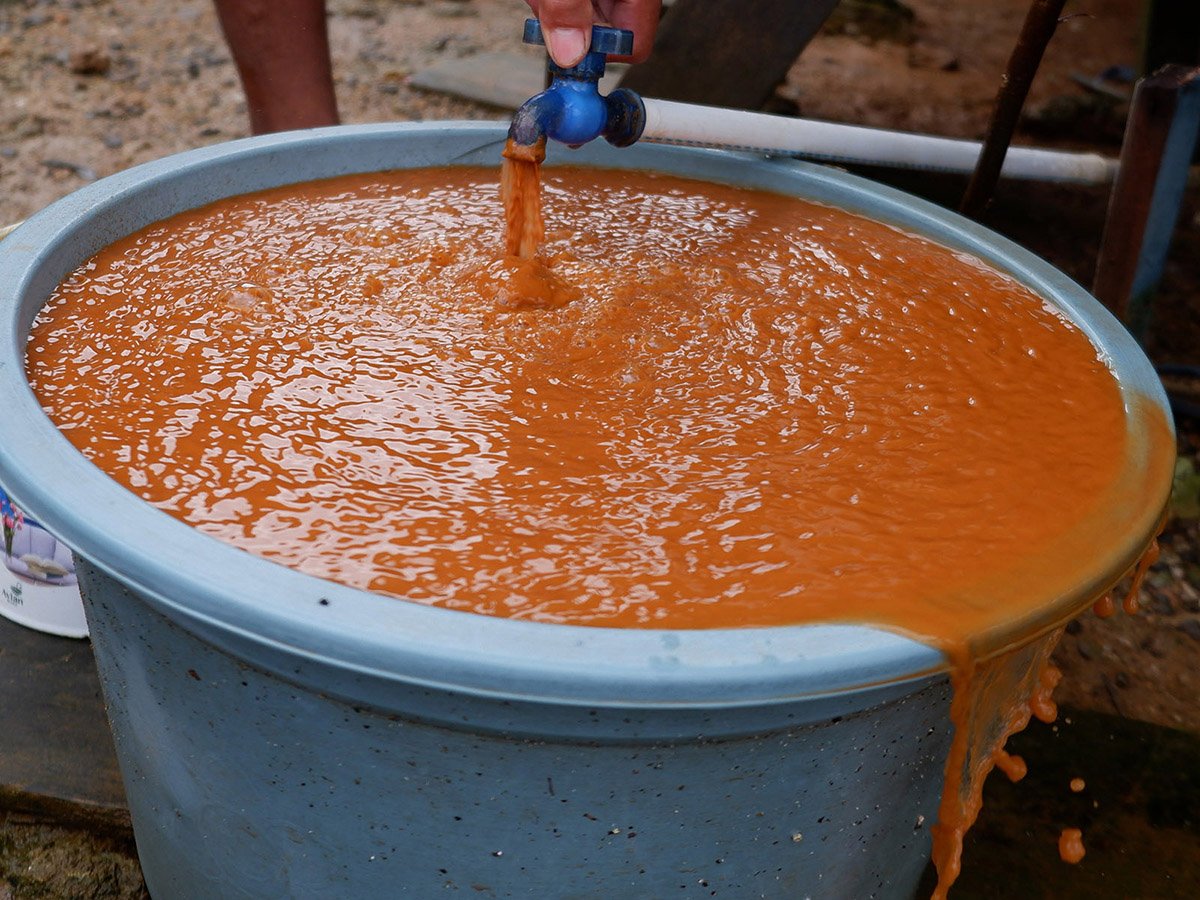
A representative of PT Gema Kreasi Perdana, Alexander Lieman, denied the company was responsible for pollution. Regarding the air pollution accusation, he said the company had implemented preventive measures—including biannual monitoring of air quality and noise levels, regular road watering, and controlling vehicle speeds.
“We undertook various programs to comply with environmental regulations and protect the environment on Wawonii Island,” Alexander said. “As a goodwill gesture, we compensated the community for crops affected in areas covered by our forest use permits (IPPKH).”
Lieman said the company didn’t cause water pollution, arguing that heavy rainfall had turned rivers murky long before mining activities began.
“Our operations did not pollute the rivers around the mining areas,” he added.
He also dismissed allegations of water contamination in Mosolo village, saying the murky water in May had only been an issue in two villages, Sukarela Jaya and Dompo-Dompo Jaya.
“We firmly rejected these accusations. You could verify this with the village government and the local Environmental Agency,” Lieman said.
He said the company had assisted affected residents by distributing clean water via trucks, deploying teams to locate alternative water sources, cleaning residents’ water storage tanks, and digging bore wells and ring wells.
“By now, the river water has cleared, and residents are freely accessing clean water for their daily needs,” he concluded.
Yet Lieman’s claims didn’t match the reality on the ground. As of 18 August 2023, the water flowing through pipes in Dompo-Dompo Jaya, Sukarela Jaya, and Roko-Roko villages remained muddy and dark brown, despite a lack of significant rainfall.
The Destruction of Gebe Island: Water Crisis and Deforestation by the Nickel Companies
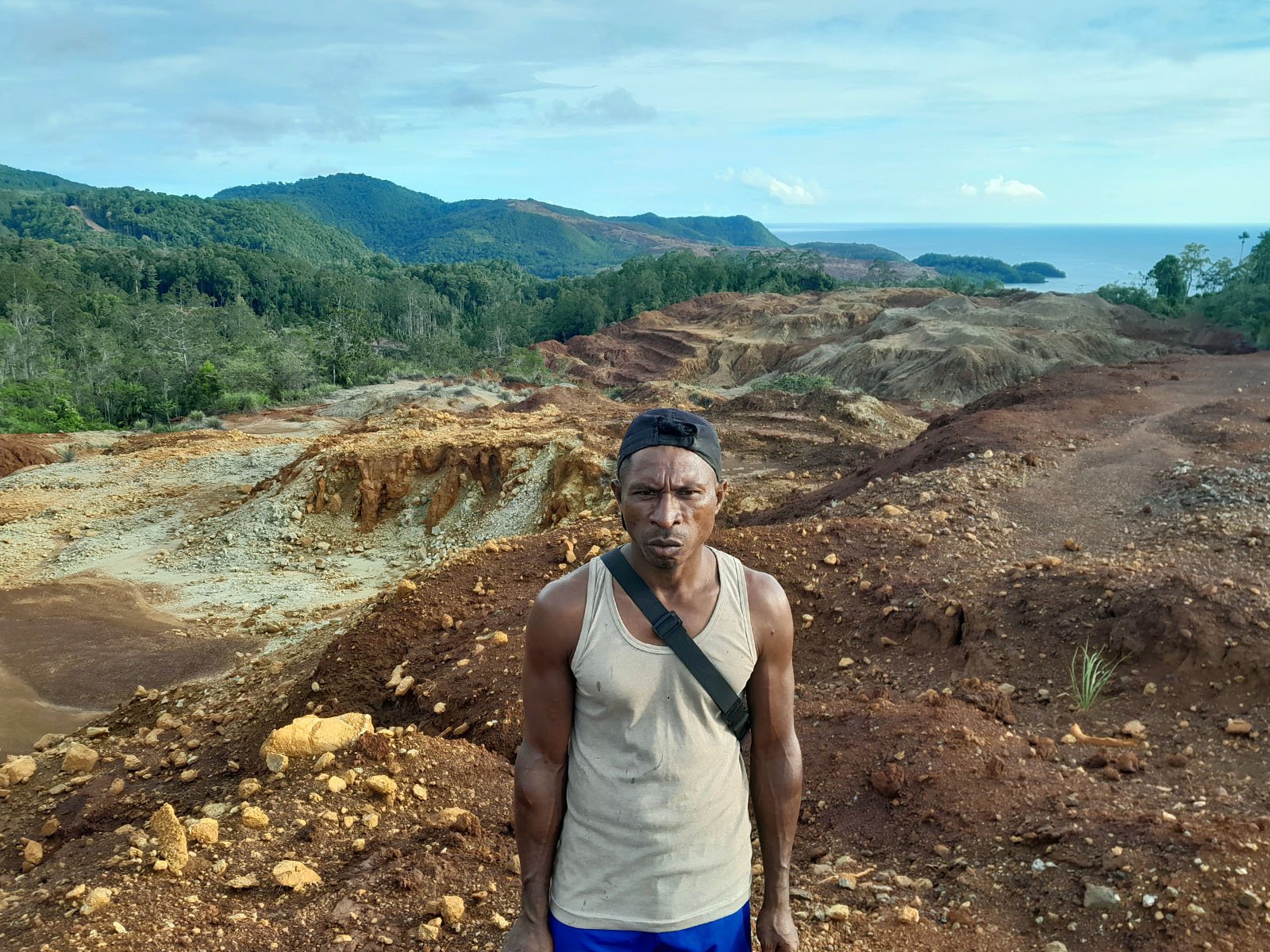
The spring that Sunardi Jafar, known as Naryo, and neighboring residents rely on is at Ueboelie Cape, less than a kilometer from their village. This vital water source has served the community for years. But it now falls within the area controlled by PT Smart Marsindo, a nickel mining company that began operations in mid-2022.
As the company continues to clear the forest and extract nickel, Naryo, 24, fears that their last dependable water source might soon disappear.
Water sources are naturally scarce on Gebe Island. The island’s landscape is dominated by coral rock formations, with no large rivers or high mountains. So residents depend on springs, wells, and lakes.
PT Aneka Tambang (Antam) began exploiting the land in the early 1980s to extract nickel ore. The state-owned company took over most of the coconut, nutmeg, clove, and sago plantations, leading to the disappearance of many natural springs, especially in hilly areas.
When Antam ceased operations in 2004, the community faced hardships. Ships that once supplied basic goods from Weda and Papua became scarce, causing distribution to become limited and prices to skyrocket. The electricity supply, which had depended on the mining company, was cut off for years. Access to clean water became a thing of the past.
PT Antam also left behind environmental destruction. Many laid-off residents turned to fishing, only to find reduced catches, while farmers struggled with pest attacks on their crops.
Now, other nickel mining corporations are occupying the island.
In 2018, 12 mining business permits were issued on Gebe Island, covering more than half the island’s area, according to the Mining Advocacy Network (Jatam). Eight of these companies (PT Smart Marsindo, PT Karya Wijaya, PT Aneka Niaga Prima, PT Mineral Trobos, PT Fajar Bhakti Lintas Nusantara, PT Anugrah Sukses Mining, PT Lopoly Mining, PT Bartra Putra Mulia) are linked to local and national political elites, party leaders, foreign investors, and individuals involved in corruption cases, notably former North Maluku Governor Abdul Ghani Kasuba.
Earlier this year, the Indonesian National Police headquarters installed a signboard in the unlicensed Lowalo area, where PT Mineral Trobos was suspected of illegal nickel mining.
PT Mineral Trobos did not respond to Project Multatuli’s inquiries, sent twice via text message in mid-Aug. 2024, regarding the illegal mining activities. On 28 August 2024, Project M sent an interview request letter to the company’s headquarters at Graha BIP, South Jakarta. Project M also sent an interview request to PT Smart Marsindo’s office in the Patra Office Tower building, South Jakarta. Both letters, which included questions about mining practices on Gebe Island, remain unanswered.
Nickel mining has caused deforestation on the island. Mining runoff contaminated mangrove ecosystems and reduced water access, while nickel dust settled on soil, damaging agriculture.
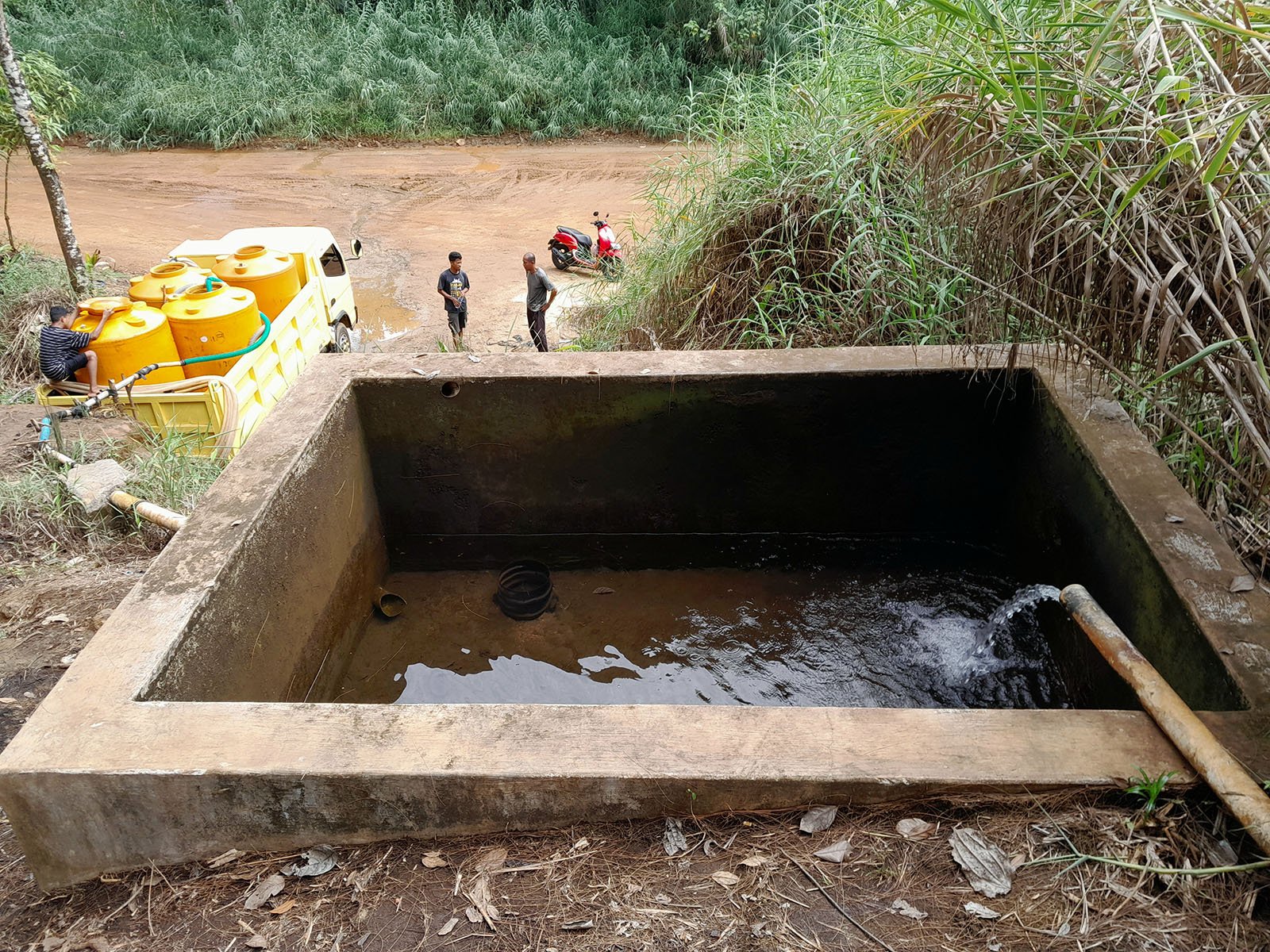
Water shortages have forced families to spend up to Rp840,000 (US$55) monthly on water delivered by transport trucks—a considerable expense given the limited income opportunities on the island.
Naryo lives in a house with walls made of half concrete and half wood, topped with a zinc roof and cement floors. This home sits within a housing compound once built for the former mining workers of PT Aneka Tambang.
When Project Multatuli visited, the water tank in Naryo’s house—supplied by the regional water company (PDAM)—stood empty. No water flowed from the tap. PDAM’s distribution is unreliable, arriving just once a week, if that, and often even less frequently, as was the case then. It had been over a month since they last had PDAM water.
Faced with this uncertainty, Naryo’s family has no choice but to rely on costly water deliveries, carefully rationing every drop they manage to buy. They store the water in their kitchen, inside a two-by-three-meter tank, doing their best
Naryo and some other residents have voiced concerns about the water crisis to government officials. Yet, these have gone unanswered.
Obi Women Struggles after the Arrival of the Nickel Industry
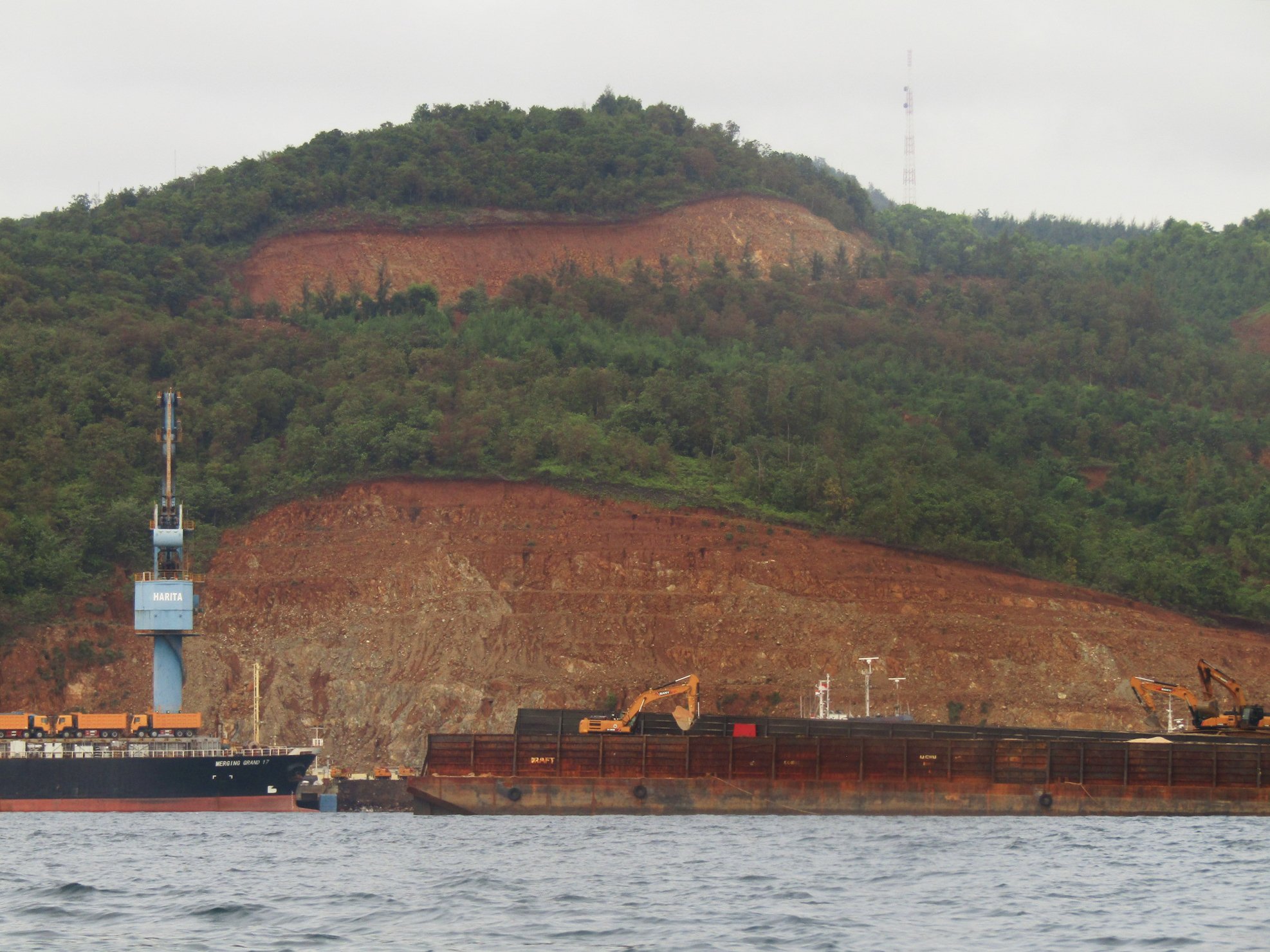
Every time Lily Mangundap of Kawasi village gazes upon the hill behind her home, a quiet fury stirs within her. Once lush with coconut and cashew trees, the hill now stands bare, stripped by the nickel industry.
In 2022, Obi Island had 12 active mining licenses, with five in Kawasi village. The licenses, covering 10,769.53 hectares—or about 80% of the village—are held by companies such as the Harita Group (PT Trimegah Bangun Persada and PT Gane Permai Sentosa), PT Halmahera Persada Lygend, PT Algifari Wildan, PT Wanatiara Persada, and PT Rimba Kurnia Alam.
Lily, born in Wayaloar and raised in Ocimaloleo, moved to the village after marrying her second husband, Andrias Datang. Andrias inherited a piece of land he cultivated from 1982 but was forced to abandon during the sectarian violence from 1999 to 2000.
Andrias later reclaimed the land, and they became farmers, planting 4,000 coconut trees and 20,000 cashew trees, hoping to secure their future. But their hope was shattered when the government claimed their land—along with five other private holdings—as state-owned without warning. The company then moved in with excavators, destroying their farm.
“The coconut trees had just sprouted leaves when it [the company] demolished them,” Lily said, trembling.
Later, Lily said, the company offered compensation based on a government decree that only covered her cashew trees, disregarding the coconuts. They set the price unilaterally, offering Rp 129.7 million, later raising it to Rp 160 million—a sum that she felt didn’t reflect the value of her land or the effort invested.
Lily and other residents refused the offer but faced intimidation—Andrias was struck with the butt of a gun, and another resident, Dominggus Johanis, was imprisoned for six months.
The land dispute caught the attention of NGOs and legal aid groups, who offered to assist. The residents poured hundreds of millions of rupiah into funding these organizations to fight their case in local courts. Eventually, the case moved to Jakarta, where it has stalled since 2018. The couple has drained all their funds, fighting a legal battle they may never win.
Magdalena Johanes, known as Aunt Magda, another resident, said nickel smelting companies took over the road leading to the fields, making access difficult. Villagers now have to use private vehicles or rent a pickup truck to reach their fields.
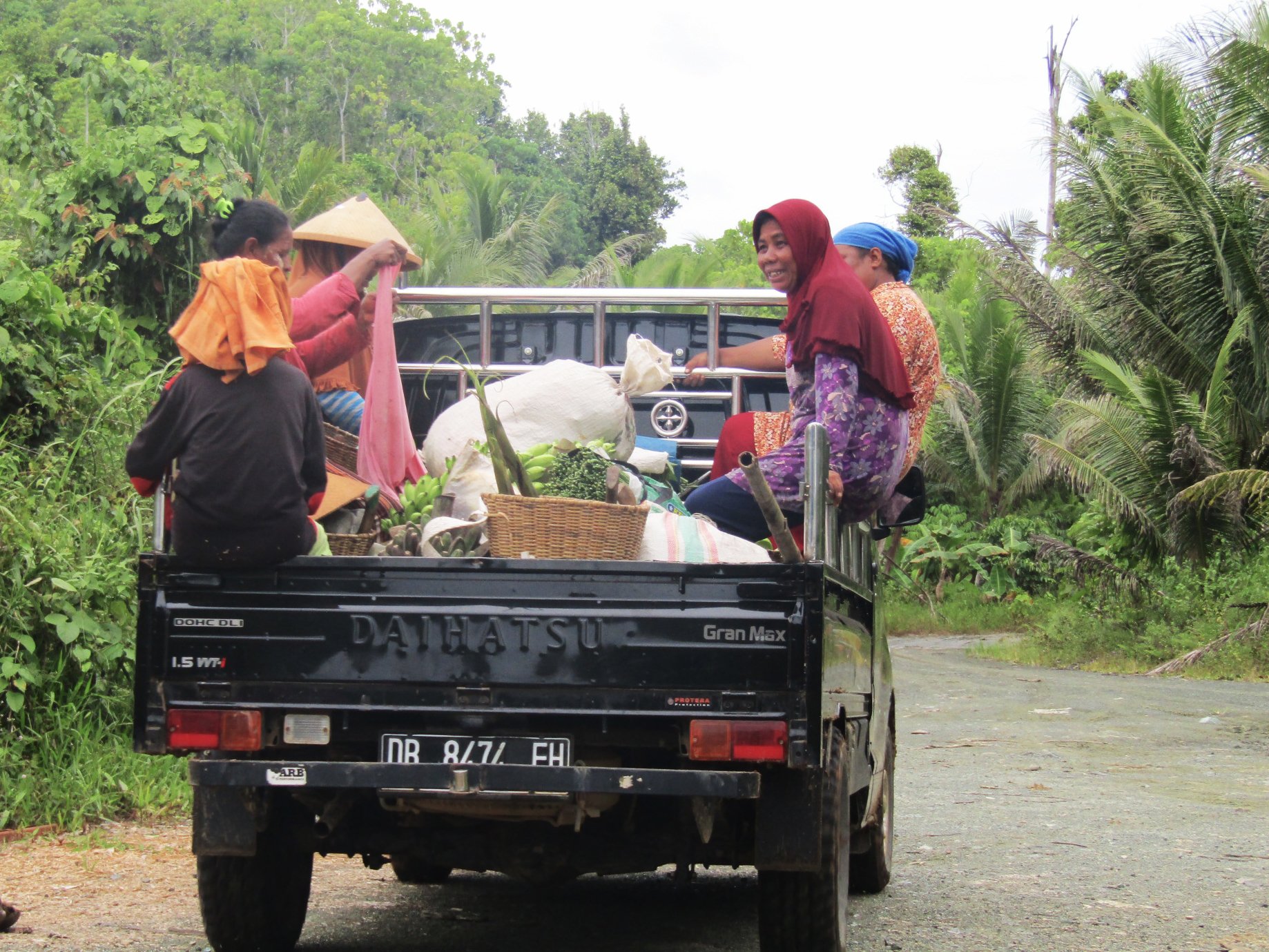
The nickel companies have also polluted water sources like the Ake Lamo and Toduku Rivers. According to Aunt Magda, villagers now rely on tap water from a nearby waterfall, but mining waste often contaminates it, making it unusable after heavy rains. With bottled water too costly, they have no choice but to continue using this contaminated water.
Daily expenses have also soared, as residents who once sourced vegetables, fish, and firewood freely now must purchase everything. Women face the added burden of constantly cleaning mining dust that settles in their homes.
Despite claims that the industry is environmentally friendly, it relies on coal-fired power plants (PLTU), adding pollution from nickel slag, fly ash, and bottom ash. The constant hum of machinery has become background noise for the villagers. “We can’t sleep [well],” Aunt Magda said.
The pollution takes a toll on the community’s health. According to the Kawasi village health post (Polindes) report from January to June 2021, cases surged with 326 acute respiratory infections (ISPA), 276 cases of fever, and 118 cases of diarrhea. Among those affected is Lily’s 6-year-old daughter, Agnes, who now suffers from repeated respiratory infections.
The industry admits pollution has contributed to illnesses but claims residents’ improper waste disposal worsened the pollution. Harita Group representative Anie Rahmi as quoted in Mongabay said that the company mitigated environmental impacts of land clearing according to environmental assessments. Anie stated that they only cleared land essential for mining, managed water flow, and planned to replant flora affected by mining activities. “Water quality downstream is monitored to ensure compliance with regulations,” Anie said.
The Disappearance of Fisher Villages
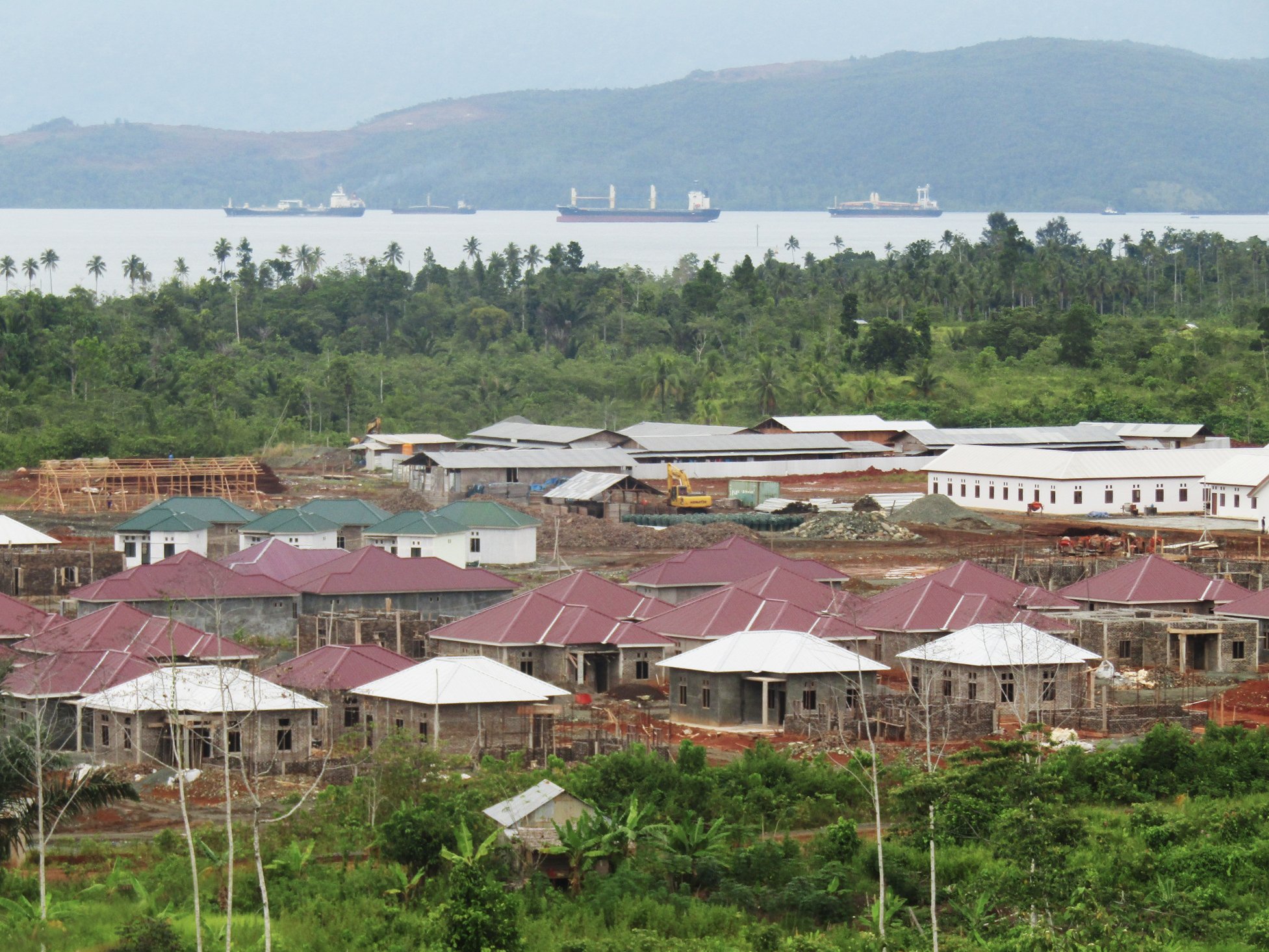
As part of a 2019 agreement between the South Halmahera Government and Harita Group, the company constructed a new village for Kawasi’s residents. This 80-hectare settlement, located about one kilometer from the coastline, has raised concerns among the community due to its distance from the ocean. Worse, the houses are deemed uninhabitable, with small, unstable structures prone to collapse during rain or subsidence.
Neither the local government nor the company communicated the relocation plan to Kawasi’s residents, leaving many anxious about moving from the coast, where they have lived and worked for generations. It’s just a matter of time until some residents are forced to relocate.
Ridwan La Tjadi, Head of the Environmental Impact Assessment Section at the South Halmahera Environmental Agency, outlined reasons for relocating the villagers. Ridwan said the current settlement was rundown, littered with trash, and disorganized. Its proximity to the coast raised concerns about rising tides and tsunamis. The village’s closeness to the industrial zone has exposed residents to disease risks, disruptions from heavy machinery, and emissions from the PLTU. The relocation is part of a broader strategic plan aimed at improving community welfare.
“Harita Nickel is also part of the solution to infrastructure issues in the operational area, including electricity, telecommunications, public facilities, and amenities,” a company representative said in a statement.
This piece, written by Anne Parisianne, presents synopses of four narrative stories originally published in Indonesian. The original articles are: “Once Nickel Arrived, the Entire Island Became Polluted” by Adrian Mulya, “’Nickel Mining Operation Is ‘Slowly Killing Us’, Indonesian Farmers Say” by Yuli Z, and “The Destruction of Gebe Island: Water Crisis and Deforestation by the Nickel Oligarchy” and “Obi Women Struggles after the Arrival of the Nickel Industry” by Rabul Sawal.

